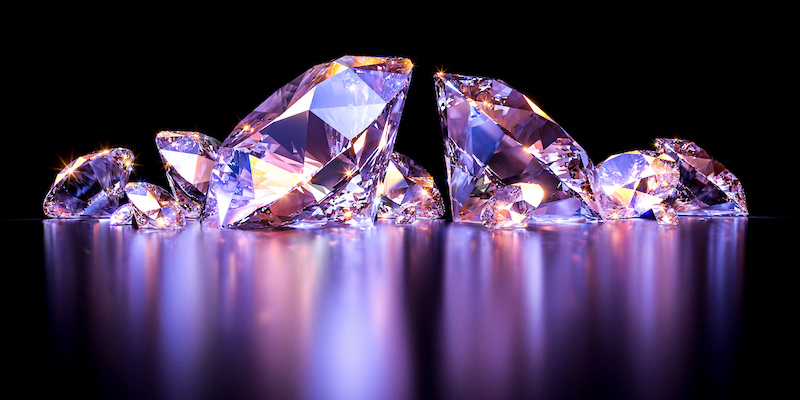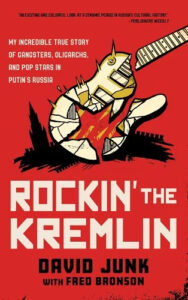One of the greatest lootings of Mother Russia since the end of the Cold War happened in 1993: a corrupt Russian bureaucrat and his young protégé concocted a scheme to help the Kremlin extort billions from the De Beers diamond cartel while secretly siphoning $180 million in raw diamonds from the Russian State Treasury to purchase luxury properties, cars, and jets around the world. Many Americans, including Hilary Clinton, Al Gore, and the mayor of San Francisco were unwittingly roped into this scheme.
At the time, I was a young, idealist American who had grown up during the Cold War, and with the Soviet Union gone, I was eager to be a bridge between former superpower enemies. I lived in San Francisco and had just earned my MBA—in other words, I was a broke student. My first job was with a new American-Russian joint venture in the diamond business, and I was certain this was my first step to bringing American know-how to Russians.
Instead, I ended up in one of the most significant crimes in the history of the diamond industry: the theft of $180M in diamonds from the Russian Treasury by a company called Golden ADA, headquartered in San Francisco and Moscow. This crime is also a story of a failed Russian-American business venture that was supposed to symbolize, at least on the surface level, the start of a new post-Cold War era—one of friendship and business between former superpower enemies.
The Berlin Wall went down in 1989, and the Soviet Union collapsed in 1991. Opportunities for Americans and Russians to do business together were unlimited in the new Russia. But Golden ADA was a ruse set up by Russians to threaten the De Beers monopoly on world diamond sales.
One of the greatest cons in the history of the world is the notion that diamonds are rare. They’re not rare. In fact, they’re plentiful and abundant, but for the longest time, the supply available on the world market was closely controlled by a South African diamond mining monopoly, the De Beers Group. By keeping the supply low and strictly controlled, they drove up the price and supported an entire worldwide industry mainly based in Antwerp, Tel Aviv, and New York. However, the largest diamond deposits in the world are located deep beneath the cold Siberian tundra. If Russia wanted, it could flood the market with Siberian diamonds, increasing the world’s supply while crashing prices down along with the entire industry.
That was perfect for blackmail. De Beers made deals with successive Kremlin leaders to keep Siberian diamonds in the ground in order to protect the diamond industry. This deal was worth $4 billion annually for the USSR.
But when the Soviet Union collapsed, so did the Russian economy. The new Russia had freedom but was broke. There were shortages, and people were standing in bread lines. Boris Yeltsin, the new president and former party boss who turned into a democracy fighter, needed cash to keep his government from failing. Russian people were angry at the economic situation, and Communists were threatening to return to power.
Fortuitously for Yeltsin, the 5-year agreement with De Beers was coming up for renewal and provided the perfect opportunity for a significant cash injection. Yeltsin thought De Beers had underpaid the USSR and believed he could extract billions more dollars if he had more leverage. To do this, he would have to bluff that Russia would walk away from the deal and sell diamonds to the world market in competition with De Beers. This would frighten them into paying Russia more.
However, no diamond companies in Russia could compete with De Beers, but Evgeny Bychkov (former Soviet technocrat and current Diamonds and Precious Metals Committee Chairman for the Russian Federation) had a quintessential Russian plan: a “Potemkin Village” but for diamonds. A “Potemkin Village” is drawn from Russian history: General Potemkin built the façade of an entire village on a riverbank to deceive Czar Catherine the Great into thinking the Russian countryside was booming as she passes by on her royal riverboat.
Under orders from Prime Minister Viktor Chernomyrdin, Bychkov planned to open a diamond-cutting factory in America where De Beers could not do business due to U.S. anti-trust laws. The Russian Treasury was to provide $500 million in raw diamonds to the factory where they would be cut, polished, and then sold. Bychkov would need to have control over the Russian and American owners of this joint venture and knew someone who could help him carry it out, Andrei Kozlenok. Kozlenok had two Armenian friends who had immigrated to the United States, brothers David and Ashot Shagarian. They would be the American side of the joint venture, and Kozlenok (“A.D.” comes from “Andrei”) would represent the Russian side. Bychkov insisted that owners not have a direct connection to the Russian government since that would run afoul to U.S. laws. They would name it Golden ADA after its founders, and the plan was approved by the Kremlin.
1993 was also the perfect year to start this joint venture, and San Francisco was the ideal place. The newly elected American President Bill Clinton made it his administration’s policy to develop stronger ties to Boris Yelstin’s young government. Clinton had campaigned on pursuing a “peace dividend” from improved superpower relations and seeing the end of mutually assured destruction, critical foreign policy goals. Democratic leaders in San Francisco had provided votes and money for the successful Clinton campaign, so it was only natural for the city to embrace Clinton’s political outreach to Russia. The San Francisco elite—from the mayor, senators, First Lady Hillary Clinton, and Vice President Gore—all welcomed the joint-venture Golden ADA. Culturally, San Francisco was the perfect place since more Russians lived there than any city outside of Russia due to a long history of migration. San Francisco also offered specific business advantages such as closeness to lucrative Asian markets.
Like the Potemkin Village built to fool the czar, this new company had to appear to De Beers and the world to be a “true” American-Russian business joint venture. The political optics were impressive: as one of the first extensive American-Russian business partnerships in the post-Cold War era, it was a shiny example of a new era of friendship between former superpower enemies. It would also give Yeltsin the leverage he needed to negotiate a much more lucrative deal with De Beers.
Golden ADA needed to quickly establish itself in the market. Andrei Kozlenok paid cash on the spot when he found the multi-level glass-shaped Diamond Mart at 999 Brannan Street in San Francisco’s South of Market business district. San Francisco’s top jewelers also had retail stores there.
To establish friendly relations with city of San Francisco, the Russians donated a Kamov Ka-32 helicopter with dual blades, meant for heavy duty forest fire fighting. When the helicopter flew in from a barge in the San Francisco Bay and landed on factory rooftop, its dual rotors were so strong that it kicked up a windstorm which smashed windows in skyscrapers and buildings surround the factory.
Of course, all I wanted was to work in Moscow—I wanted to build bridges between former superpower enemies. I saw Golden ADA as my ticket to Russia, and not long after getting hired in San Francisco, I was sent to manage the Golden ADA office in Moscow and became their American representative in Moscow.
Golden ADA’s spending spree caught the attention of the FBI and then the IRS. Fifty agents raided the factory and seized Golden ADA’s assets, but Kozlenok and the brothers were on the run. Kozlenok converted $178 million in diamonds to cash to finance a luxury spending spree that included paying $1 million in cash for a Rolls Royce and two Astin Martins, a high speed cigarette boat, three luxury yachts, properties in Bermuda and Antwerp, and 18 properties in Northern California, including $4.4 million paid in cash for the Lake Tahoe estate where The Godfather Part II was filmed. Golden ADA also paid $18 million for a Gulfstream Jet used to transport the diamonds from Moscow to San Francisco.
When the authorities raided the company’s Moscow office, they found me and raided my home. Naturally, I fell under the investigator’s spotlight, and the Russian State Prosecutor accused me of direct involvement in the crime. I was innocent. Those who had the diamonds were on the run. Interrogation sessions in the prosecutor’s office were grueling, and my life in the new Russia quickly became a nightmare.
The “Dirty Diamonds” scandal made headlines globally and was featured on the U.S. News and World Report cover with the Golden ADA ringleader Andrei Kozlenok in handcuffs. Eventually, the Russian State Prosecutor cleared me of any connection to the stolen diamonds, and I would go on to build cultural bridges between Russia and the West as the first CEO of Universal Music Russia.
***


















